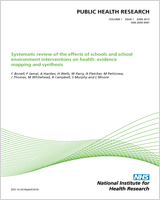Included under terms of UK Non-commercial Government License.
NCBI Bookshelf. A service of the National Library of Medicine, National Institutes of Health.
Crombie IK, Falconer DW, Irvine L, et al. Reducing alcohol-related harm in disadvantaged men: development and feasibility assessment of a brief intervention delivered by mobile telephone. Southampton (UK): NIHR Journals Library; 2013 Sep. (Public Health Research, No. 1.3.)

Reducing alcohol-related harm in disadvantaged men: development and feasibility assessment of a brief intervention delivered by mobile telephone.
Show detailsIntroduction
This study assessed the feasibility of a randomised controlled trial to determine the impact of a novel intervention delivered by text message on drinking behaviour among disadvantaged young to middle-aged men. This was achieved by carrying out all of the stages of a pragmatic randomised controlled trial, with a particular focus on how well each stage was conducted. The aim of this close scrutiny was to identify whether or not a full trial would succeed and what improvements could be made to the conduct and likely effectiveness of the trial. The study was conducted in three phases.
Phase 1 comprised six focus groups to develop the recruitment strategy, to optimise the design of the text messages and images and to determine the most acceptable sequence for their delivery. Five focus groups were conducted with men and one focus group with women. The focus groups explored drinking behaviour and attitudes and beliefs about drinking, its benefits and harms. The findings from this phase were also used to help develop the intervention.
Phase 2 involved the planned recruitment of 60 participants who were randomised to receive either the alcohol intervention or general health promotion messages. This phase was conducted in a series of distinct steps. As the target group was disadvantaged young to middle-aged men, recruitment to the study was given careful attention. The intervention was a series of interactive text messages and images designed using messaging theory, social cognition models, motivational interviewing (MI) and systematic reviews of interventions to tackle alcohol problems. The intervention was delivered to mobile telephones using a programmed computer system. Participants were followed up for 3 months to assess retention, willingness to respond to text messages and to complete the final assessment of drinking behaviour. The aim of this assessment was to determine whether or not the outcomes could be readily measured on the participants. Although the feasibility study was not powered to detect changes in drinking behaviour, it could give an indication of whether or not the intervention might be effective in a full trial.
Phase 3 involved interviews with 20 participants to assess the acceptability of the intervention, the impact it had on their willingness to moderate their drinking and factors that might limit their ability to drink less. The aim was to assess the acceptability of all aspects of the study and to identify opportunities to improve the intervention.
The chapters of the report
This report is laid out as a series of 12 chapters which provide a forensic analysis of the design, conduct and outcome of the feasibility study. Chapter 2 begins with an outline of the research objectives of the feasibility study. Chapter 3 identifies the motivation for the study and then explores the main design challenges which needed to be addressed. This is followed by eight chapters which provide a description of the series of interlinked substudies which were conducted to meet the aims of the feasibility study. Each chapter is self-contained, comprising an introduction, methods and results sections, together with a discussion which summarises the main findings and assesses their significance in the light of previous research. This approach is appropriate because each substudy had a distinct purpose and a specific set of methods. Combining methods or discussion sections into single chapters would lose the close relationship between methods, results and discussion which is essential for a full forensic evaluation. The individual substudies are:
- Chapter 4, Understanding drinking motives and behaviours
- Chapter 5, Developing the text messages
- Chapter 6, Recruitment strategies
- Chapter 7, Randomisation and baseline characteristics
- Chapter 8, Retention strategy
- Chapter 9, Outcome assessment
- Chapter 10, Process evaluation
- Chapter 11, Post-trial assessment.
Chapter 12, Summary and conclusions, has three linked aims. It presents a concise synthesis of the main findings from the whole feasibility study, together with their implications for future research. It then assesses the extent to which the feasibility study met its aims. Finally, it makes recommendations for modifications to the protocol which will improve the conduct and outcome of the proposed full trial.
- Structure of the report - Reducing alcohol-related harm in disadvantaged men: de...Structure of the report - Reducing alcohol-related harm in disadvantaged men: development and feasibility assessment of a brief intervention delivered by mobile telephone
Your browsing activity is empty.
Activity recording is turned off.
See more...